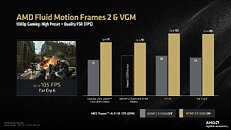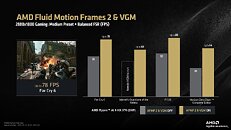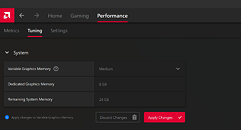- Joined
- Oct 9, 2007
- Messages
- 47,598 (7.45/day)
- Location
- Dublin, Ireland
| System Name | RBMK-1000 |
|---|---|
| Processor | AMD Ryzen 7 5700G |
| Motherboard | Gigabyte B550 AORUS Elite V2 |
| Cooling | DeepCool Gammax L240 V2 |
| Memory | 2x 16GB DDR4-3200 |
| Video Card(s) | Galax RTX 4070 Ti EX |
| Storage | Samsung 990 1TB |
| Display(s) | BenQ 1440p 60 Hz 27-inch |
| Case | Corsair Carbide 100R |
| Audio Device(s) | ASUS SupremeFX S1220A |
| Power Supply | Cooler Master MWE Gold 650W |
| Mouse | ASUS ROG Strix Impact |
| Keyboard | Gamdias Hermes E2 |
| Software | Windows 11 Pro |
AMD today released early driver support for the Radeon 800M series integrated graphics of Ryzen AI 300 series mobile processors to use AMD Fluid Motion Frames 2 (AFMF 2), and Variable Graphics Memory (VGM) technologies. The two technologies receive optimization for the RDNA 3.5 graphics architecture driving the iGPU of the "Strix Point" silicon on which the Ryzen AI 300 series processors are based on. AFMF 2 is the second generation of AMD Fluid Motion Frames, a technology that lets you nearly double frame-rates on any Direct3D 11 or later game, without the gaming having explicit support for a frame generation technology, such as FSR 3 Frame Generation. AFMF operates out of the game's graphics pipeline, which adds a tiny bit of system latency. AFMF 2 seeks to reduce this latency.
Variable Graphics Memory (VGM) is another interesting feature that builds on top of the UMA (unified memory architecture) implementation of AMD processors with iGPUs. Depending on a 3D application's demands, the technology dynamically allocates up to 75% of the system memory as video memory for the iGPU, while ensuring the game doesn't run into unintentional performance bottlenecks arising from paging main memory if too much of it is used up by the iGPU. For VGM to work, a system needs at least 16 GB of main memory. VGM is not meant to be confused with the shared memory area that the processor allots to the iGPU by default (which ranges between 512 MB and 2 GB), it's designed to augment to this by eating into the system memory.



AMD posted its first party benchmark results on how VGM enables significant performance improvements in AAA games such as "Far Cry 6," "Marvel's GotG," "F1 23," and "Horizon: Zero Dawn." GotG in fact needs VGM enabled to even play on the Radeon 890M iGPU of the Ryzen AI 9 HX 370 processor. AMD also posted its performance results for a combination of AFMF 2 and VGM being enabled, where the four games are shown posting 30-50% increases in frame-rates. Both technologies can be managed in the Performance>Tuning section of AMD Software.


To let those with a notebook powered by the Ryzen AI 300 series mobile processor experience the two technologies, AMD released an off-branch Technical Preview driver bearing version number 24.20.11.01, which works on Windows 11 and Windows 10 64-bit. You can find the driver here.
View at TechPowerUp Main Site
Variable Graphics Memory (VGM) is another interesting feature that builds on top of the UMA (unified memory architecture) implementation of AMD processors with iGPUs. Depending on a 3D application's demands, the technology dynamically allocates up to 75% of the system memory as video memory for the iGPU, while ensuring the game doesn't run into unintentional performance bottlenecks arising from paging main memory if too much of it is used up by the iGPU. For VGM to work, a system needs at least 16 GB of main memory. VGM is not meant to be confused with the shared memory area that the processor allots to the iGPU by default (which ranges between 512 MB and 2 GB), it's designed to augment to this by eating into the system memory.



AMD posted its first party benchmark results on how VGM enables significant performance improvements in AAA games such as "Far Cry 6," "Marvel's GotG," "F1 23," and "Horizon: Zero Dawn." GotG in fact needs VGM enabled to even play on the Radeon 890M iGPU of the Ryzen AI 9 HX 370 processor. AMD also posted its performance results for a combination of AFMF 2 and VGM being enabled, where the four games are shown posting 30-50% increases in frame-rates. Both technologies can be managed in the Performance>Tuning section of AMD Software.


To let those with a notebook powered by the Ryzen AI 300 series mobile processor experience the two technologies, AMD released an off-branch Technical Preview driver bearing version number 24.20.11.01, which works on Windows 11 and Windows 10 64-bit. You can find the driver here.
View at TechPowerUp Main Site




